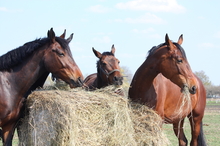The U.S. Department of Agriculture Farm Services Agency (FSA) is offering assistance to ranchers hit by the severe drought in parts of the U.S. This assistance will help both horse and cattle owners by allowing haying and grazing on public lands.

More hay and grazing for horses and cattle
Assistance to ranchers hit by the severe drought in parts of the U.S. will help both horse and cattle owners by allowing haying and grazing on public lands.
Under defined conditions, ranchers and farmers affected by persistent drought will be able to temporarily use certain Conservation Reserve Program lands for grazing and haying. Farmers and ranchers who use these lands must ensure they adhere to the conservation and wildlife safeguards of CRP, according to a statement from the USDA.
The voluntary CRP pays producers annual rental payment when they improve wildlife habitat, enhance environmental stewardship and plant vegetation that preserves the environment and prevents erosion, for example. Because of continued drought in many areas of the U.S., FSA offices across the country have allowed haying and/or grazing on CRP lands in more than 430 counties.
USDA also reduced CPR rental payments related to these emergency uses from 25 percent to 10 percent, while also allowing the sale of hay under specific conditions.
“Beginning August 7, 2013, state FSA offices are authorized, under limited conditions, to expand opportunities for haying and grazing on certain additional lands enrolled in CRP,” FSA Administrator Juan Garcia said in a statement. “This local approach provides both the appropriate flexibility and ability to tailor safeguards specific to regional conditions.
States must adhere to specific guidelines to ensure that additional haying and grazing still maintains the important environmental and wildlife benefits of CRP. These safeguards will be determined through consultation with the state conservationist, state fish and wildlife agency and stakeholders that comprise the state technical committee.”
The U.S. Southwest is in the midst of a multiyear drought, with many areas in Texas, New Mexico, Oklahoma, Kansas, Nebraska, Wyoming and Colorado categorized as extreme and exceptional drought, according to the latest U.S. Drought Monitor. Last year’s hot and dry summer led to increased hay and feed prices affecting both horse and cattle owners.
